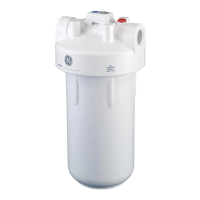2
Filter Cartridge Replacement
You should change your filter when the water flow is noticeably reduced or at least every 3 months.
Turn off water to filter. Water must be shut off from
an upstream valve.
Press the red pressure-release button to release
pressure.
Unscrew the filter canister and discard used filter.
Wash the filter canister with mild soap and water.
Do not use harsh cleaners or hot water.
Inspect the filter canister O-ring. Make sure it is
lightly lubricated with clean food-grade silicone
grease (silicone grease is available through GE
Parts and Service: 1.800.626.2002, part number
WS60S10005). Be sure the O-ring is seated in the
groove. It is recommended that you replace the
O-ring if it is damaged.
Place a new filter cartridge into the canister,
making sure it is centered and completely seated
on the bottom seal.
Reinstall the filter canister to the unit. Use the
canister wrench to tighten the canister. DO NOT
OVERTIGHTEN.
Slowly turn on water to the filter by using the
upstream shut-off valve.
Press the red pressure-release button to remove
trapped air.
After installation, flush the cartridge for
15 minutes.
9
8
7
6
5
4
3
2
1
Installation Overview
NOTE: Be sure to allow a minimum space
of 1
1
⁄2 ″–2″ under the filter for removing
the sump to change the cartridge.
Turn canister wrench
clockwise to remove
Canister
Turn
clockwise
to remove
canister
Turn
counterclockwise
to tighten
Red pressure-
release button
Filter
cartridge
O-ring seal
Filter canister
Head
STEP-BY-STEP INSTALLATION INSTRUCTIONS
Recommended
shut-off valve
Recommended
shut-off valve
Fitting
Ferrule
Hex nut
Fitting
Ferrule
Hex nut
1
1
⁄2 ″–2″
Typical installation
Remote timer
Mounting
bracket
CARTRIDGE SPECIFICATIONS
Influent Challenge Reduction Average
Substance Concentration Requirements Reduction
Standard 42
Chlorine 2.0 mg/L ± 10% ≥ 50% 93.1%
Performance Data
This system has been tested according to NSF/ANSI 42
for the reduction of the substances listed at right. The
concentration of the indicated substances in water
entering the system was reduced to a concentration
less than or equal to the permissible limit for water
leaving the system, as specified in NSF/ANSI 42.
FXHTC Cartridge
Test Conditions
Flow Rate: 4 gpm (15.1 Lpm)
pH: 7.5± 1
Inlet Pressure: 60 PSI (4.1 bar)
Temperature: 68°F ± 5°F (19.8°C ± 2.5°C)
Operating Requirements
Pressure: 30–125 PSI (2.1–6.9 bar)
Turbidity: 5 NTU Max.
Temperature: 40°F–100°F (4.4°C–37.7°C)
Capacity: 30,000 gallons (113,562L) or 3 months
Testing was performed under standard laboratory conditions; actual performance may vary.

